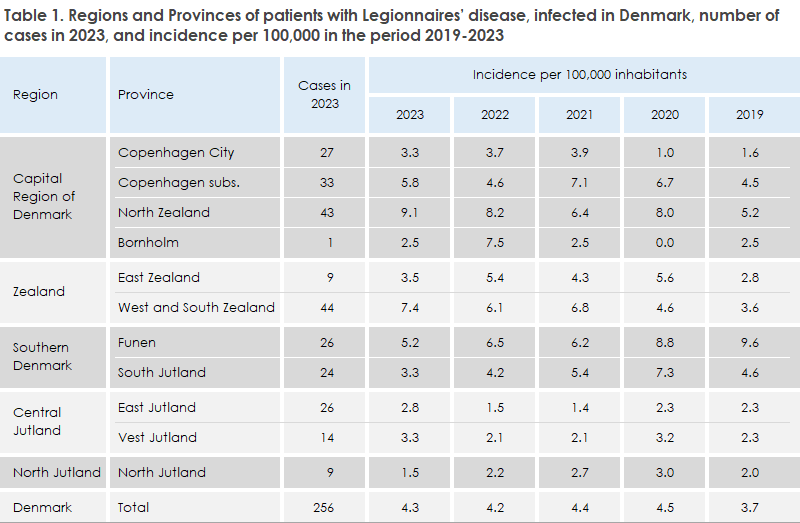No 34 - 2024
Legionnaires’ Disease in Denmark 2023
Legionnaires’ Disease in Denmark 2023
In 2023, 313 cases of Legionnaires’ disease (LD) were registered among residents in Denmark, including 198 men (aged 31-98 years, median age 70.5 years) and 115 women (aged 30-96 years, median age 73 years). A total of 256 cases are believed to have been infected in Denmark (81.8%), Table 1. In 2023, 57 were infected while traveling abroad (18.2%). Most were infected in the United Arab Emirates with eight cases, followed by Greece with seven cases.
For a detailed description of disease trends in 2023, refer to the Annual Report on Legionella in 2023.
Mortality, with 35 cases in 2023, fell to a normal level (11.2%) after several years of higher mortality rates of 14.5% in 2020/2021 and 19.5% in 2022. The proportion of elderly people with Legionnaires’ disease remained high with 179 cases ≥ 70 years (57.2%), while mortality in this age group was significantly lower in 2023 (16.2%) than in 2022 (27.2%).

As seen in Table 1, several areas saw an increase in incidence in 2023 compared to 2022: Copenhagen suburbs, North Zealand, West and South Zealand, East Jutland, and West Jutland. The incidences in Bornholm and in East Zealand have decreased compared to 2022, but small population sizes in these areas make them sensitive to random fluctuations. Overall, the incidence for the entire country was 4.3 cases per 100,000 inhabitants, the same level as in recent years.
It should be noted that some mild cases or cases in the early phase of Legionnaires’ disease (possibly without productive cough) are not PCR-positive (estimated around 20-30%), as it can be difficult to obtain sample material of sufficient quality, and the Legionella content may be low. Some of these patients have serogroup 1 infection and can often be detected by Legionella urinary antigen test (UAT), while some particularly mild cases are likely to be negative in both tests.
It is recommended to perform PCR tests for both Legionella species and for L. pneumophila. A positive PCR test for Legionella species has a low predictive value for the diagnosis of Legionnaires’ disease, meaning that some of the results may be false positives or have unknown clinical significance. However, it is likely that there are more cases caused by non-pneumophila Legionella species than generally assumed.
In Sweden, outbreaks with L. longbeachae have previously been detected in people handling processed soil/growth media in connection with gardening, and now again in 2024, 30 cases with the same exposure have been confirmed. In 2023, there was only information that one of the Danish patients diagnosed with L. longbeachae had handled processed soil/growth media. However, so far in 2024, six cases with L. longbeachae (four culture-confirmed) have been detected after handling potting soil or other soil improvement products, of which some are known to contain peat. The developments are being closely monitored in cooperation between the Danish Patient Safety Authority, the Danish Agricultural Agency, and Statens Serum Institut. Preventative measures to reduce the risk of infection through handling processed potting soil and similar products include working outdoors, moistening the soil carefully to reduce dust, using gloves that do not come into contact with the face during work, and washing hands and face thoroughly after handling.
(C. Eves, C. Kjelsø, Department of Infectious Disease Epidemiology and Prevention, S. A. Uldum, Department of Bacteria, Parasites, and Fungi)